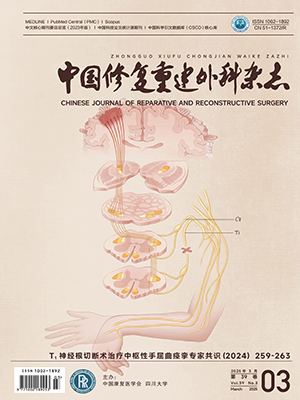To discuss the effect of dexamethasone in preventing fat embol ism syndrome (FES) in cemented hi p arthroplasty patients. Methods Forty patients scheduled for unilateral cemented hi p arthroplasty between January 2008 and December 2009 were randomly divided into trial group (n=20) and control group (n=20). In trial group, there were 6 males and 14 females with an average age of 73.2 years (range, 54-95 years), including 4 cases of osteoarthritis, 3 cases of
avascular necrosis of femoral head, and 13 cases of femoral neck fracture; the disease duration was 4 days to 6 years (median, 0.8 year). In control group, there were 10 males and 10 females with an average age of 71.9 years (range, 59-91 years), including 2 cases of osteoarthritis, 3 cases of avascular necrosis of femoral head, and 15 cases of femoral neck fracture; the disease duration was 3 days to 5 years (median, 0.6 year). There was no significant difference in gender, age, or disease duration (P gt; 0.05) between 2 groups. Cemented total or bipolar hip arthroplasty (with the same brand of cement and prosthesis) in 2 groups were performed by a group of surgeons. The patients were given intravenously injected with dexamethasone (20 mg) in trial group before 1 hour of cement injection and intravenously injected with normal sal ine (2 mL) in control group. Amount of 5 mL vein blood were withdrawn before surgery, after 4, 8, and 24 hours of cement injection to test the number and average diameter of fat droplets. According to Gurd diagnosis standard, related FES symptoms and signs were inspected. Results Primary heal ing of incision was achieved in all cases of 2 groups. According to Gurd standard of diagnosis, no FES occurred in each group at 2 weeks postoperatively; deep venous thrombosis occurred in 2 cases (10%) of trial group and in 5 cases (25%) of control group, showing significant difference (P lt; 0.05). The number and diameter of fat droplets in trial group were significantly lower than those in control group at 4, 8, and 24 hours of cement injection (P lt; 0.01). All cases were followed up 7.4 months on average (range, 3-13 months). The postoperative Harris score was 89.5 ± 6.1 in trial group and 87.9 ± 8.3 in control group, showing no significant difference (P gt; 0.05). No loosening occurred during follow-up period. Conclusion Intravenous injection with
dexamethasone can effectively reduce the number and diameter of venous fat droplets in cemented hip arthroplasty, which can decrease the risk of postoperative FES.
Citation: JIANG Junwei,WANG Hongchuan,WANG Yongcai.. CLINICAL STUDY ON EFFECT OF DEXAMETHASONE IN PREVENTING FAT EMBOLISM SYNDROME AFTER CEMENTED HIP ARTHROPLASTY. Chinese Journal of Reparative and Reconstructive Surgery, 2010, 24(8): 913-916. doi: Copy
Copyright © the editorial department of Chinese Journal of Reparative and Reconstructive Surgery of West China Medical Publisher. All rights reserved




